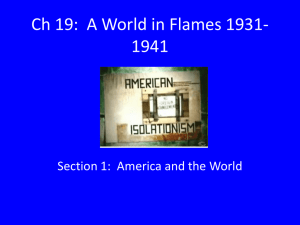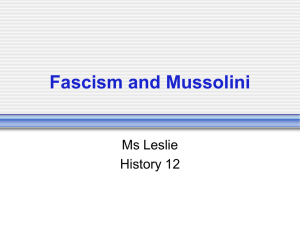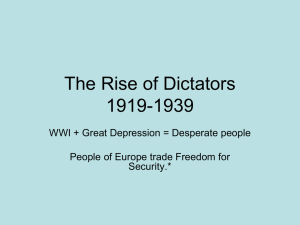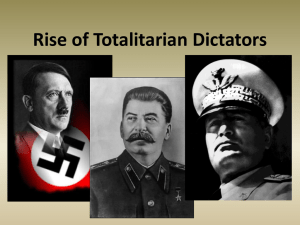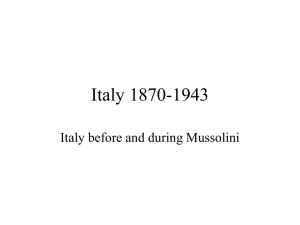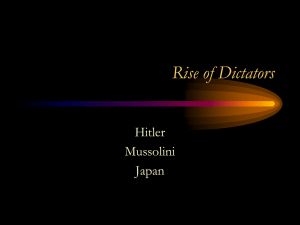Document
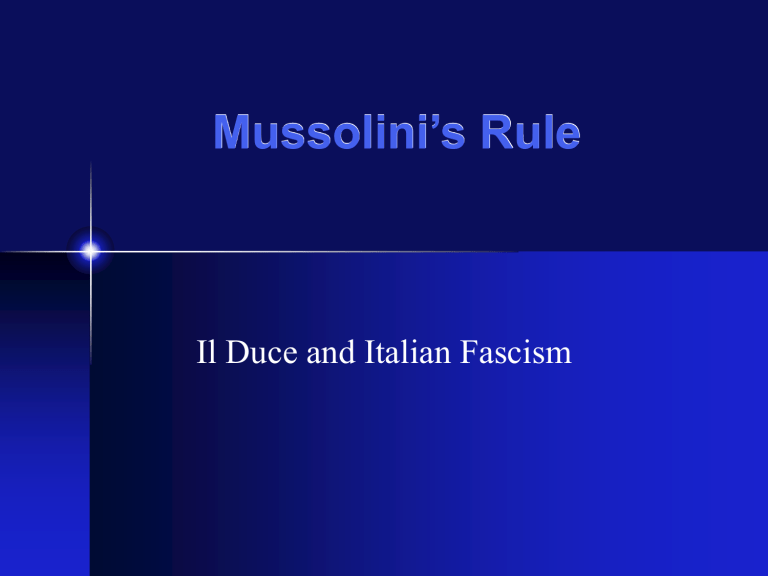
Mussolini’s Rule
Il Duce and Italian Fascism
Fasces
Fasces is a symbol originally used in ancient Rome to represent the power of the empire. Mussolini used it for his political uses for two reasons: to go backwards to the glorious time of the Roman empire and to conjure fear of the the leader. http://www.pntic.mec.es/mem2001/scripta/res/archiv_res/Res7.htm
(left) http://freepages.genealogy.rootsweb.com/~wingrove/family-crest.htm
(right)
Italia Irredenta
• Italia Irredenta was land promised to italy by
Britain and France for her support in World War
One (in these lands were ethnic italians). This did not help to solve the unrest that was present in
Italy.
Benito Mussolini or Il Duce
• Mussolini was the leader and Founder of the Italian Fascism,
Fascisti, party. He was an early socialist but when he realized that stronger support could be gotten from the right wing all socialist aspects were dropped. http://www.worldwarhistory.com/wwii/biographies/mussolini.htm
Fascisti and Italian Parliament
• The Fascisti is the
Italian Fascism party founded by Mussolini.
This party would by
1922 march on rome and by doing this putting Mussolini as leader of a collision government.
• Italian Parliament consisted of 535 seats and by 1921 the
Fascisti party only had
35 seats. In 1928
Mussolini had eliminated all parts of parliamentary democracy from the
Italian Government.
Blackshirts and ‘Mare Nostrum’
• The fascist party grew at an incredible rate by drawing on exservicemen middle class youth and anticommunists. As well to give its members importance they gave them a uniform and the name Blackshirts.
• Mare Nostrum translated means ‘our sea’. Mussolini used this along with Give italy a Place in the sun” to refer to the mediterranean.
Acerbo law and Giacomo
Matteoti
• The Acerbo Law was pushed through parliament to guarantee two thirds majority in the chamber of deputies for the Political party that got the most votes. In 1924 this gave Mussolini a vast majority.
• Giacomo Matteoti the leader of the socialists, spoke out against the
Fascists and
Mussolini, and 11 days later was killed. He was one of many parties that were eliminated by 1926.
OVRA and Lateran Accords
• In 1927 Mussolini established the OVRA or secret police. The secret police are, as for any Fascist rule, important to maintain order because they are used to instill fear in the populace to maintain order.
• The lateran Accords were agreements with the Catholic church,
Mussolini’s last possible opposition.
These agreements were the elimination of his final opposition.
Corporate State Law and Fascist
Grand Council
• In the Italian
Corporate State management and workers supposedly ran everything together. However it suppressed the rights of the workers and centralized the economic planning.
• In 1928 the Fascist
Grand Council was given the power to decide who would be on the council of
Deputies. By doing this Mussolini could surround himself by people he wanted.
Concordat 1929 and Stresa
Front
• The concordat was a part of the Lanteran Treaties which made the Roman
Catholic church the state religion. When the support of the church was given to Mussolini the people who did not originally support
Mussolini but who supported the Church were moved to support
Mussolini.
• The stresa front was an informal alliance between
Brittan france and Italy whose goal was to prevent
Nazi Germany from extending her borders in to other countries, more specifically Austria.
When the agreement fell apart (in five months after the English signed the
Anglo-German Naval
Agreement) Italy was forced by public option closer to Nazi Germany.
Abyssinia and Austria
• In 1935 when Mussolini’s army invaded Abyssinia the Abyssinians stood no chance against a the modern Italian army. The result of this was a very week response by the
League of Nations which put no real damaging economic sanctions on
Italy, rather they did not restrict much that italy could not get from the US
(a non league nation).
• When Hitler was threatening to invade Austria (to bring the roughly million ethnic germans back under German control) Mussolini threatened support to the
Austrian’s if hitler did not back down. France supported a free Austria and therefore supported this action by Mussolini, however this would lead to more of a surprise when
Mussolini tries to invade
France.
Axis Pact and Anti-Comintern
Pact
• The Pact of Steel or Axis
Pact was the agreement by
Germany and Italy to support the other if the other became involved in a war. The forcing
Minister Galleazo Ciano thought the pact was likely damaging however
Mussolini wanted to align himself with the most powerful country in
Europe.
• In 1937 Italy joined the anti-comintern pact
(which was already established between the
Germany and Japan in which they agreed to, in the event of an unprovoked attacked consult on what measures to take.
This agreement is just one of a long list of pacts and treaties that Hitler would eventually break.
Albania And The ‘stab in the back’
• On Good Friday of
1939 Mussolini conquered Albania.
Mussolini viewed this as a sign of the increase in italy’s power however
Albania was with in
Italy’s influence already.
• On June 10 1940
Mussolini ‘stabbed france in the back’ by attacking
France; however he gained very little from the
French army (which would surrender to the germans 7 days later).
This would begin the
Italian involvement in
WWII which would eventually lead to catastrophic losses.
Listen to the declaration of war by Mussolini on June 10 1940.
Audio clip from http://www.thehistorychanel.com
. It was the Speech of the day a while ago
Greece and North Africa
• When the Italian army attacked Greece they were going to face yet another humiliating defeat. This was
‘preparation in a way for the eventual loss to the Allies.
• The war in North
Africa was yet another blow to the Italian military. By december
1940 violent attacks by the English would force Mussolini to request assistance from Hitler.
The end Is in Milan
• When the Allies capture southern italy they also managed to capture and hold Mussolini until Hitler rescued him and placed him as a puppet ruler in northern Italy. This would last until the people hung
Mussolini and his wife by the feet from a garage in
Milan and shot them. This was the end of Mussolini and Fascism in Italy.
Introduction-Action Over
Thought
• The artist of the cartoon
Mussolini presents a very strong opinion against
Mussolini. The artist focuses on the fascist idea of “action over thought”.
The artist shows considerable amount of time and effort in to building an army.
The cartoon
• As well it shows
Mussolini doing a lot of posturing and showing off. The artist shows a variety of things about
Mussolini.
Mussolini a Pompous Fool
• The best way to summarize all of them is that Mussolini is a pompous fool
.
A functioning Military
• One clear idea was that the Italians could not form a functioning military in spite of the large amount of time they had to build it.
Here again we see the idea of action over thought prevailing over Mussolini.
The Cartoon’s Important Years
• The artist shows an action in each year from 1922 to 1941.
Some are historical facts others are symbolic of actions taken by Mussolini
1922
In 1922 Mussolini conducts his march on Rome. This gives him moderate power in the Italian government.
As well the artist shows the Italian flag in the background. This is symbolic of the aggressive nationalism that Mussolini used to gain support.
1926
• By 1926 Mussolini had eliminated all opposition. The artist depicts this by placing everyone in line saluting him.
1927
• In 1927 he is building up his military power, here the artist shows it using the guns.
1931
• In 1931 the artist shows Mussolini flying (or pretending to fly) a plane. As well there are two aircraft in the air beside him.
1932
• In 1932 the artist shows Mussolini in an admiral hat watching over the navy as well there are 3 planes in the air. Here the reader can see the growth of the navy and military as a whole.
1933
• In 1933/34 when
Mussolini threatens to send troops to the
Austrian border to prevent an attack from
Hitler the artist shows this as flexing his muscles.
1934
• In 1934 the artist shows Mussolini’s even bigger army now with 5 guns not just 3.
1935
• In 1935 the artist shows
Mussolini as a roman emperor leaning against the Fasces–a depiction of extreme power. As well the artist is playing upon the idea of his wanting to expand his empire to the size of the Roman Empire.
1936, 1937, 1938, and 1939
• Again in 1936, 1937,
1938, and 1939 we see the increasing size of
Mussolini’s army. As well during these years he uses the same salute as Hitler. By this time Hitler’s rule was overshadowing
Mussolini’s.
1940
• In 1940 Mussolini is depicted as having a large army. It is in this year that he declares war on France and
Britain.
1941
• By 1941 he is depicted as having nothing no army no followers. As well he is blaming his loss on the idea that
“We weren’t Ready”.
Personal Response
Identify and Explain the reasons for the rise of fascism in Italy
Personal Response
For the upper and middle class of Italy workers
(strikes, demands for better wages etc) and socialism in general were a threat to their way of life. After World War I, in Italy, there was general
Resentment for the outcome of WWI. Mussolini saw both these problems and used them to achieve power in Italy. However it was not just the events that allowed Mussolini to gain power but also his political abilities. For example Mussolini managed to conduct his ‘March on Rome’ unopposed.
Personal Response
• In Italy after WWI there was talk of the socialist “revolution that was bound to come”. This caused fear in the traditional ruling class that hadn’t quite realized how to use a full (though open to men only) democracy to there advantage. At this time the peasants in the countryside were trying to change the way ownership of land worked by simply taking land. The Rural workers were forming ‘unions’ like groups to force employers to provide better wages and working conditions. The urban workers were going on strike to get wages back to the value that they were at before the inflation caused by the war. Mussolini saw all of this and shifted his party from moderately social to an anti-social party. By doing so he gained the support of all the employers and all the supporters of the “movement against the masses of the people”.
Personal Response
• Mussolini also managed to capitalize on the feeling of betrayal by the allies. During
WWI the allies promised certain land to
Italy should Italy give its support to the allies: ‘Italia Irrendetia’. However at the end of the war the allies only gave Italy a small fraction of the land that she was promised. This translated into support for
Mussolini’s aggressive nationalism.
Personal Response
• It was not just the luck of the way that the events happened that brought Mussolini to power but also the individual people involved: Mussolini and the king Emanuel III. Mussolini was a talented politician. His march on Rome was conducted with out opposition. However this was not just due to the way Mussolini managed his supporters but also due to the week will of the king. Emanuel
III chose not to support parliament and merely let
Mussolini in to Rome and finally Emanuel III asked Mussolini to form a government giving the fascist the final step into power.
Personal Response
• A Variety of reasons allowed for
Mussolini’s rise to power, each reason was vital and supported the others. The time was right for a leader like Mussolini.
However if it weren’t for the leadership abilities of Mussolini and the lack of leadership of the king it would not have worked out for the Fascists.
Howarth Response
Page 51-53 of Twentieth Century
History
The world since 1900
By Tony Howarth
Howarth Response
The main question that Howarth answers is ‘How and why did the
Fascists rise to power in Italy?’ To answer the how he looks at
Mussolini’s views and how they found him a place in the political turmoil of the Italian democracy. There is also the answer to the question why? Howarth believes part of the reason for Mussolini’s rise is the march on Rome and part on the people “they had thrown away their right to disagree”. However it was in fact not the majority of people who brought people to power but it was the king who asked Mussolini to form a government. When Mussolini did so he forced though a bill that gave the party with the most votes at least two thirds majority in the parliament. By doing this it would then allow Mussolini to take control of the state. In this process the majority of the people are not needed in giving him his power but rather the largest minority group. The one place I do agree with
Howarth is in the area of his description of Mussolini as a “rogue, liar and bully” for that he was.
Howarth Response
Howarth assumes that everyone reading the text will support his views for democracy, because he does not bother to prove or explain is accusation that
Mussolini is an awful person and that “Italian politics in the twenties is …very sorry”. When he describes Italian politics he does not even bother to explain it more than it was under a fascist regime. Howarth also places blame upon the people of Italy for Mussolini’s rise when, as I have said before, it was truly the lack of a will by
Emmanuel III.

